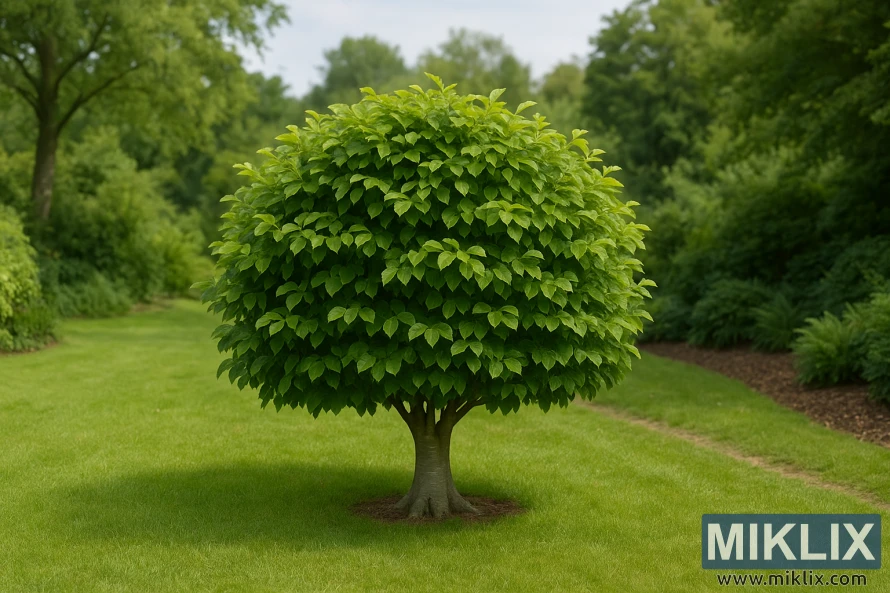Image: Dwarf European Beech
Published: August 28, 2025 at 10:13:39 AM UTC
Last updated: September 28, 2025 at 8:34:54 AM UTC
A Dwarf European Beech with a dense globe-shaped canopy of glossy green leaves adds elegance and structure, perfect for compact garden spaces.
In this serene garden landscape, a Dwarf European Beech (Fagus sylvatica ‘Nana’) stands as a living sculpture, embodying both elegance and restraint in its compact form. Unlike its towering relatives that spread broad canopies across vast lawns, this variety channels its energy into a neat, globe-shaped crown that appears almost perfectly symmetrical. Its dense foliage, a mass of glossy green leaves, overlaps in layers, creating a textured surface that feels both lush and deliberate, as though shaped by a careful hand even though the tree’s natural growth habit ensures this tidy appearance with little need for intervention. The leaves, slightly pointed and finely veined, capture the light in shifting tones of green, giving the canopy a shimmering quality that enlivens the otherwise tranquil setting.
The tree’s sturdy, smooth gray trunk supports this rounded mass of foliage with quiet strength. Unlike larger beech specimens whose trunks often disappear into expansive root flares and sprawling crowns, the dwarf beech displays a more compact structure, with a proportion that makes the trunk itself an essential part of the composition. At its base, the roots anchor firmly into the manicured green lawn, suggesting resilience and permanence, while the ground around it is kept neat and uncluttered, further highlighting the tree’s sculptural presence. This simplicity enhances the tree’s role as a focal point, drawing the eye to its form rather than to any distractions.
Set against a backdrop of softly blurred shrubs, taller trees, and a winding garden path, the dwarf beech achieves a rare balance between formality and naturalness. The softly curving path adds movement and contrast to the beech’s perfect roundness, while the surrounding greenery frames it like a piece of living artwork on display. In this way, the tree does not dominate the landscape with overwhelming size, but instead elevates it through refined presence, proving that grandeur can be found in compact form.
The appeal of Fagus sylvatica ‘Nana’ lies in its adaptability. Ideal for smaller gardens, urban courtyards, or formal settings where space is limited, it offers all the sophistication of a beech tree without the demands of its larger kin. Its slow growth rate ensures it retains its tidy proportions for decades, requiring minimal pruning or maintenance, while its dense canopy provides texture and shade in even the smallest of outdoor spaces. Beyond its ornamental qualities, the tree offers seasonal interest: fresh green foliage in spring and summer, warming golden tones in autumn, and a clean, architectural silhouette in winter when bare branches reveal its rounded framework.
As a design element, the Dwarf European Beech is a versatile choice. It works beautifully as a specimen tree standing alone in a lawn, as seen here, or as part of a more formal arrangement, lining pathways or marking entrances with geometric precision. It can also be paired with shrubs and perennials to provide contrast in form and texture, serving as the evergreen structure around which a garden’s seasonal drama unfolds. Its neat, globe-like canopy recalls the clipped forms of topiary but with far less intervention, offering a natural refinement that appeals to both traditional and modern garden aesthetics.
This image captures not only the physical attributes of the dwarf beech but also the sense of balance it brings to its environment. By combining restrained growth with timeless beauty, it demonstrates how even the smallest trees can have a profound impact on the atmosphere of a garden. Elegant yet understated, resilient yet delicate in form, the Dwarf European Beech proves itself a masterpiece of nature’s design, embodying the very qualities that have made beeches beloved in landscapes for centuries, now perfectly adapted for intimate, compact spaces.
The image is related to: Best Beech Trees for Gardens: Finding Your Perfect Specimen

